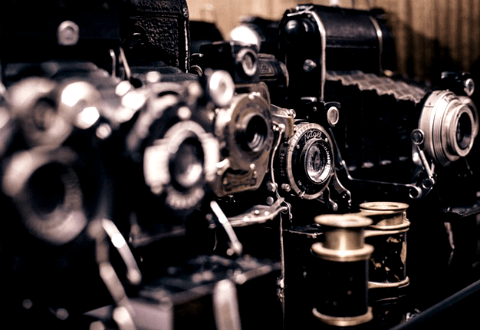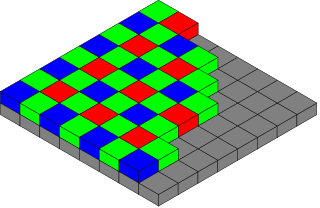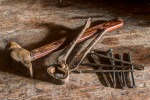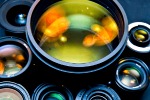Cameras for landscape photography:
The best picks
Resuming our talk about photography gear, let's get down to your best camera options.
 Those were the days...
Those were the days...Vintage cameras on display
You may want to rotate your phone in order to improve your browsing experience on this site.
NB: Time doesn't stand still, neither does progress. New products have appeared on the market since this article was first published. While an update is in preparation, be sure to check follow-up models for cameras presented below.
Quick links
"Conventional" cameras
There isn't much discussion on the topic, but very few digital camera buyers and users are aware of the fact that most digital sensors on the market only record as little as one third of the available light, and estimate the rest.
Read it again. Take your time to let it sink. Then ask a simple, logical question, How come?
A ubiquitous digital sensor records, in fact, a mixed monochrome version of an image. The light falling on the sensor is namely routed through a mosaic filter allowing only one colour component – red, green, or blue – to reach every photosite, that is, pixel cell behind it.
 Bayer filter colour pattern on the pixel array of a camera sensor
Bayer filter colour pattern on the pixel array of a camera sensorThus, each cell stores the exact intensity of one colour channel, and uses its surrounding cells to restore the information about own filtered-out portions. This results in a full-colour image whose content is for two-thirds ... an educated guess.
Fujifilm use a modified colour pattern in their X-series cameras. This is even more biased towards green light than the original: Fujifilm X-Trans sensor matrix
Fujifilm X-Trans sensor matrix
Recommended landscape photography cameras
That said, there is nothing wrong in using a mainstream camera. If nothing else, you are at least guaranteed to get firmware updates, compatible lenses and batteries for quite some time to come.
Chances are, though, you may be overwhelmed by the number of choices available in this category. (That's why they call it "mainstream", mind you.) If you don't have any brand preference yet, I would suggest to look closer at the following options:
- Nikon D810. Not so long ago, it seemed that Nikon had lost the digital race and wouldn't recover again. Well, they hadn't, and they did. The D810 is now nearly two years old and still an unsurpassed benchmark in the landscape camera photo equipment category. With its 36MP full-frame sensor, base ISO of 64, dynamic range rivaling that of medium-format cameras, and vast selection of compatible quality lenses to boot, this is hands down the best conventional digital landscape camera out there. Maybe It won't perform as well as the competition in low-light situations, but hey, so be it.
Buy from Amazon.com
Buy from Amazon.ca
Buy from Amazon.co.uk - Pentax K-1. Fresh from the assembly line, this 36MP full-frame DSLR features one of the highest dynamic ranges available and a very attractive price tag. Most notably, making up for sensor's implied colour blindness, the camera introduces a special pixel shift technique. When activated, it takes four exposures of a scene, with the sensor shifted by one pixel at a time in every direction. This allows for the complete colour information to be recorded at each pixel and combined in the final image. [Bring your own tripod.]
Not everything is rosy, though. You will struggle to find many quality lenses working properly with camera's full-frame sensor. Ricoh, the brand's owners, are well aware of the situation and doing overtime on remedy.
Buy from Amazon.com
Buy from Amazon.ca
Buy from Amazon.co.uk - Sony Alpha 7R II. Sony were late to enter the serious digital game, but their first outing on the DSLR market, soon after buying out Konica Minolta's photo department, made quite an impression. The first in the Alpha series of cameras, A100, was introduced, almost to a day, ten years ago. The 7R II went a long way from there. It is the ultimate mirrorless camera, the only one on the market featuring a full-frame sensor with backside illumination. Its 42+ MP resolution, high dynamic range and remarkable performance in low-light conditions make it the most versatile camera in this roundup. This isn't a proverbial landscape photographer's dream come true, but with a multitude of lenses available for the camera mount from all major manufacturers, it is a good all-rounder and a sure bet.
Buy from Amazon.com
Buy from Amazon.ca
Buy from Amazon.co.uk - Fujifilm X-Pro2. I have to admit, I am partial to the producers. The unacclaimed champions of quirky, they got high merits in the field of landscape photography. Their GX617 medium-format panoramic camera is legendary, as are the 35mm TX series, a.k.a. XPan. The X100, a digital compact with oh so retro looks, made such a splash on its debut in March 2011 that many a witness were left rubbing their eyes in disbelief. X-Pro2 is the pinnacle in the same series to date. It is a rangefinder-style, mirrorless system camera with a 24MP APS-C-size sensor, excellent image quality, and a very traditional shooting experience.
Buy from Amazon.com
Buy from Amazon.ca
Buy from Amazon.co.uk - Ricoh GR II. Not exactly cheap for what's on offer, and quite on the edge of the wide-angle range, Ricoh's update of their successful pocket-size travel compact is still worth considering as a lightweight backup option. While the camera features the same resolution and field of view as its predecessor, they are nevertheless rather impressive in a body this small. The 16MP APS-C sensor and the 28mm equivalent f2.8 lens deliver solid image quality in RAW, but the body isn't weatherproof. The original GR is still available and also recommended.
Buy from Amazon.com
Buy from Amazon.ca
Buy from Amazon.co.uk
"True-colour" digital cameras
And now for something completely different. Based on the same principle as colour film, Foveon X3 sensors combine three stacked photosensitive layers capable of recording all additive colours – red, green, and blue – for every pixel in the image. The sensors have been developed and exclusively used by Sigma Corporation. The resulting images, understandably, render the colour much more exactly and naturally.
On the other hand, the chips are noisier at high ISO settings and produce smaller images, albeit featuring more physical pixels (since every image pixel is built up from three sensor cells). Thus, the Sigma SD1 DSLR equipped with a 46MP big sensor has an actual resolution of roughly 15MP (4,704x3,136).
Still, the image quality at low ISO levels is unrivaled. The latest generation of Foveon X3 sensors, the Quattro series, include 4 times as many pixels in the blue layer as in any of the other two, effectively increasing the output size. The 29MP sensors produce images just short of 20MP big (5,424x3,616).
Sigma digital camera options
In February 2016, Sigma announced two new camera bodies built around the Quattro sensors sized in both APS-C and the bigger APS-H format, the latter sporting a crop factor of 1.3 and 6,192x4,128 image pixels. The new cameras will accommodate all modern lenses with the SA mount. Be sure to check the Impression section under the link above for some real-life test images.
For the time being, you have the following alternatives to try something truly unique and original in the camera photo equipment department:
- Sigma SD1 Merrill. The bad news first. The camera rolled out in 2012. The sensor features 15MP effective pixels (i.e., this is how big your images will end up) but needs ages to write them down. The camera remains pretty much locked during this time. ISO levels beyond 800 are of no use. Autofocus with its 11 points is no match for modern cameras. Adobe Camera Raw doesn't support the camera's RAW format, so you are stuck with Sigma's own Photo Pro software which is … unorthodox, to put it mildly.
On the other hand, the image quality at low ISO is exceptional, with very fine detail and natural colours. If you think this outweighs camera's quirks, and you are prepared to overcome them—give it a try.
Buy from Amazon.com
Buy from Amazon.ca
Buy from Amazon.co.uk - Sigma dp0/dp1 Quattro. The two fixed-lens compact cameras are based on the APS-C Foveon X3 Quattro sensor with effective 19.5MP. They are equipped with full-frame equivalent 21mm f4 / 28mm f2.8 lenses. Both cameras share the same strikingly designed body and offer similar characteristics and performance. Much thought went into achieving a perfect balance between the sensor and its respective lens. An optional electronic viewfinder is available for the series, as are dedicated optical viewfinders for each camera.
The image quality at low ISO is second to none, while the autofocus is rudimentary, low-light capabilities are primitive, and there is no video whatsoever. The series also comprise two other cameras, dp2 and dp3, featuring 45mm and 75mm equivalent lenses, both f2.8. Do have a look at the interactive comparison in image quality hosted by DPReview.
The cameras are by no means pocketable. If size does matter to you, try hunting down a model from the previous generation, built upon a 15MP Merrill sensor.
Buy from Amazon.com
Buy from Amazon.ca
Buy from Amazon.co.uk
35mm film cameras
This is pretty easy. The only advanced conventional film camera still in production is Nikon's F6 SLR. I doubt they make any profit from it, and highly appreciate the effort. It's been available since 2004. Show me just one digital model with a comparable run, and we can start talking about how digital is superior in every way. Beware though. As one buyer put it on Amazon,
“Camera will not work with CompactFlash or other digital media cards.
You must buy a cartridge of tape, which allows for just 24 shots. No LCD screen for image playback. Extremely frustrated and returned item."
I do hope this was meant to be ironic.
Buy from Amazon.com
Buy from Amazon.ca
Amazon.co.uk lists the camera as discontinued by manufacturer, which isn't exactly inline with Nikon Europe's official presentation. Try to locate the camera elsewhere
In addition, numerous "fun" fixed-lens film cameras are available from brands like Holga and LOMO.
If you want to try your hand at a bare-bones film camera with some decent lenses existing for its mount, Nikon FM10 might be the answer. The camera is actually based on the CT-1 body from Cosina and in fact manufactured by the latter since 1995, no less. The mode of operation is all-manual except for some assistance with the light metering, if you care to insert optional batteries. If you can find it cheap, this is a great learning piece, not something to make your living from. Aim for the body-only version.
Search at Amazon.com
Search at Amazon.ca
Tags: #landscapephotography #photocameras #photogear
Other photography equipment
- Cameras best suited for landscape photography
- Following the thread about what is most important for landscape photography equipment, let's discuss some worthwhile options.
- Landscape photography ♥ panoramic cameras
- Ever wanted to try one? Read about your current options!
- How to choose a camera lens
- Everything you need to know when looking for a new camera lens, in one place: manufacturers, mounts, formats, types, and how to understand all those mystic lens labels.
- Understanding digital camera lenses – and their reviews
- Understand how to tell good digital camera lenses from the rest when reading their reviews.
- Best camera lenses for landscape photography
- The last article on camera lenses presents some fine choices for selected cameras.
- Filters for landscape photography
- Learn how to use most useful landscape photography filters!
- Polarising filter
- One of the most striking photography filters available is hard to imitate and easy to master. Try it!
Unattributed images on this page are sourced from Wikimedia Commons.
Tell me what you think!
Is it useful 👍? Awful 👎? Leave a message! Your comments help make this site better (and give me a kick—one way or another).
Popular articles
-
A kind of magic
If a digital picture has to be seen in the real world, printed on a real medium and displayed in a real showcase, its transition from RAW to real is better done in an old school image editor. Enter A…
-
A duck for a dog
If you got your own place on the Internet, helping your visitors find what they are looking for is a great way to engage them and keep them staying a bit longer. A custom site search can achieve just …
-
"Might as well have the best"
Aiming for better images? Think better lenses! This is your most important piece of gear, so you better get it sorted out. — Need some advice?
 Become a patron for
Become a patron for